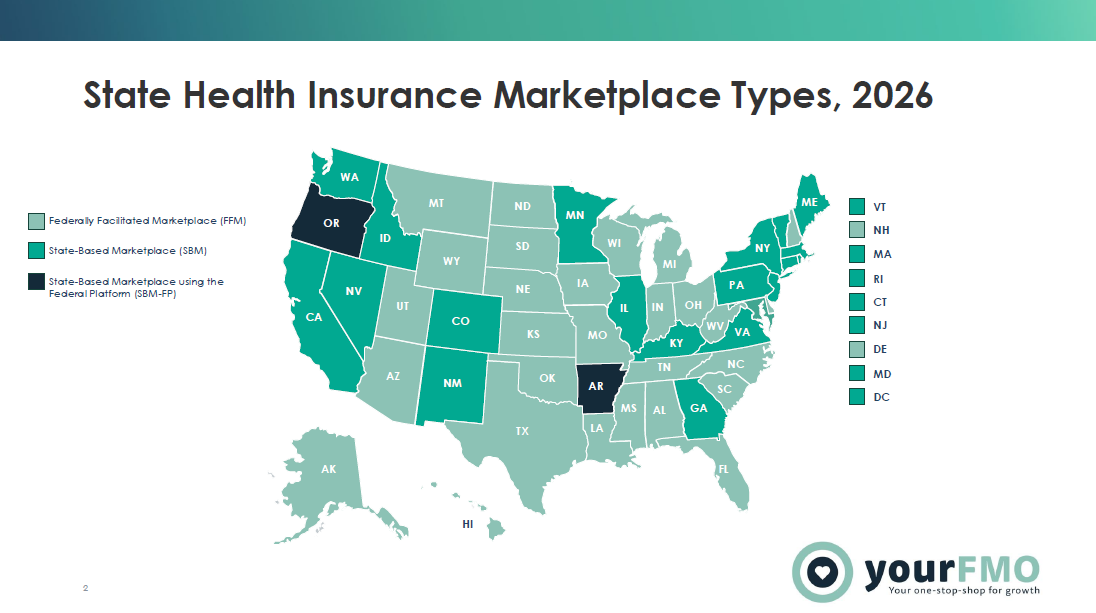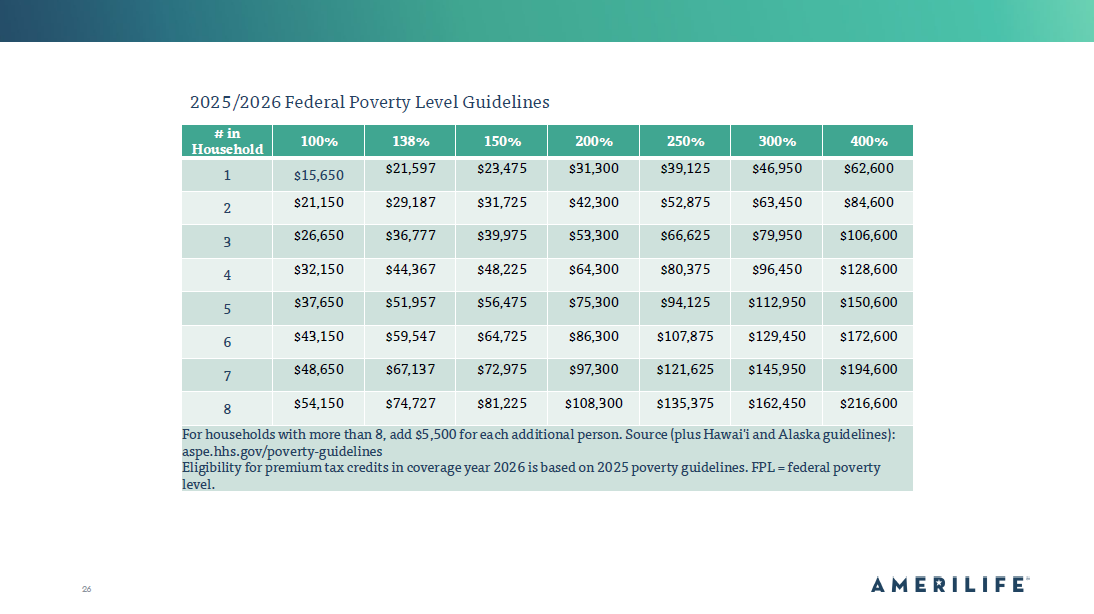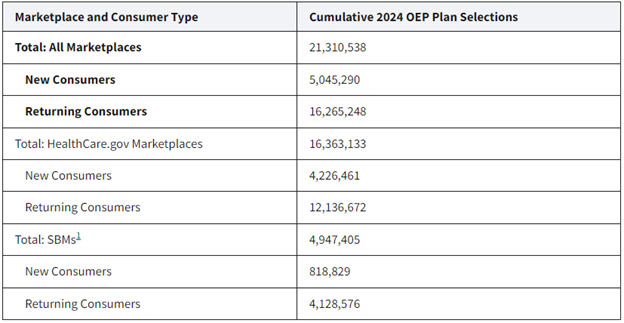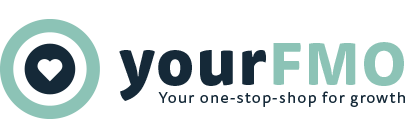YourFMO ACA Industry Trends
State Health Insurance Marketplace Types, 2026

The Sliding Scale
That sliding scale is called the Applicable Percentages Table. The applicable percentages were lowered significantly between 2021 and 2025. It reduced the amount that many people pay for their ACA health insurance. These percentages will go up sharply in 2026.
Here are the applicable percentages for different income levels in 2025 and 2026:

Medicaid Expansion
The Affordable Care Act’s (ACA) Medicaid expansion expanded Medicaid coverage to nearly all adults with incomes up to 138% of the Federal Poverty Level ($21,597 for an individual in 2025) and provided states with an enhanced federal matching rate (FMAP) for their expansion populations.
To date, 41 states (including DC) have adopted the Medicaid expansion and 10 states have not adopted the expansion. Current status for each state is based on KFF tracking and analysis of state expansion activity.

PY2026 Open Enrollment Roadmap
Federal Poverty Level Chart
How federal poverty levels are used to determine eligibility for reduced-cost health coverage
- Income above 400% FPL: If your income is above 400% FPL, you may now qualify for premium tax credits that lower your monthly premium for a 2024 Marketplace health insurance plan.
- Income between 100% and 400% FPL: If your income is in this range, in all states you qualify for premium tax credits that lower your monthly premium for a Marketplace health insurance plan.
- Income at or below 150% FPL: If your income falls at or below 150% FPL in your state and you’re not eligible for Medicaid or CHIP, you may qualify to enroll in or change Marketplace coverage through a Special Enrollment Period.
- Income below 138% FPL: If your income is below 138% FPL and your state has expanded Medicaid coverage, you qualify for Medicaid based only on your income.
- Income below 100% FPL: If your income falls below 100% FPL, you probably won’t qualify for savings on a Marketplace health insurance plan or for income-based Medicaid.
“Income” above refers to “modified adjusted gross income” (MAGI). For most people, it’s the same or very similar to “adjusted gross income” (AGI). MAGI isn’t a number on your tax return.

Medicaid Expansion
Medicaid expansion & what it means for you
Some states have expanded their Medicaid programs to cover all people with household incomes below a certain level. Others haven’t.
Whether you qualify for Medicaid coverage depends partly on whether your state has expanded its program.
- In all states: You can qualify for Medicaid based on income, household size, disability, family status, and other factors. Eligibility rules differ between states.
- In states that have expanded Medicaid coverage: You can qualify based on your income alone. If your household income is below 133% of the federal poverty level, you qualify. (Because of the way this is calculated, it turns out to be 138% of the federal poverty level. A few states use a different income limit.)
Status of State Action on Medicaid Expansion Decision (Map Below)

Marketplace Enrollment Snapshot

Enrollment by State
| Location | Marketplace Type | Total Consumers Who Have Selected a Marketplace Plan |
| United States | 19 State-based Marketplace; 2 State-based Marketplace using the Federal Platform; 30 Federally-facilitated Marketplace | 21,446,150 |
| Alabama | Federally-facilitated Marketplace | 386,195 |
| Alaska | Federally-facilitated Marketplace | 27,464 |
| Arizona | Federally-facilitated Marketplace | 348,055 |
| Arkansas | State-based Marketplace-Federal Platform | 156,607 |
| California | State-based Marketplace | 1,784,653 |
| Colorado | State-based Marketplace | 237,106 |
| Connecticut | State-based Marketplace | 129,000 |
| Delaware | Federally-facilitated Marketplace | 44,842 |
| District of Columbia | State-based Marketplace | 14,799 |
| Florida | Federally-facilitated Marketplace | 4,211,902 |
| Georgia | Federally-facilitated Marketplace | 1,305,114 |
| Hawaii | Federally-facilitated Marketplace | 22,170 |
| Idaho | State-based Marketplace | 103,783 |
| Illinois | Federally-facilitated Marketplace | 398,814 |
| Indiana | Federally-facilitated Marketplace | 295,772 |
| Iowa | Federally-facilitated Marketplace | 111,423 |
| Kansas | Federally-facilitated Marketplace | 171,376 |
| Kentucky | State-based Marketplace | 75,317 |
| Louisiana | Federally-facilitated Marketplace | 212,493 |
| Maine | State-based Marketplace | 62,586 |
| Maryland | State-based Marketplace | 213,895 |
| Massachusetts | State-based Marketplace | 311,199 |
| Michigan | Federally-facilitated Marketplace | 418,100 |
| Minnesota | State-based Marketplace | 135,001 |
| Mississippi | Federally-facilitated Marketplace | 286,410 |
| Missouri | Federally-facilitated Marketplace | 359,369 |
| Montana | Federally-facilitated Marketplace | 66,336 |
| Nebraska | Federally-facilitated Marketplace | 117,882 |
| Nevada | State-based Marketplace | 99,312 |
| New Hampshire | Federally-facilitated Marketplace | 65,117 |
| New Jersey | State-based Marketplace | 397,942 |
| New Mexico | State-based Marketplace | 56,472 |
| New York | State-based Marketplace | 288,681 |
| North Carolina | Federally-facilitated Marketplace | 1,027,930 |
| North Dakota | Federally-facilitated Marketplace | 38,535 |
| Ohio | Federally-facilitated Marketplace | 477,793 |
| Oklahoma | Federally-facilitated Marketplace | 277,436 |
| Oregon | State-based Marketplace-Federal Platform | 145,509 |
| Pennsylvania | State-based Marketplace | 434,571 |
| Rhode Island | State-based Marketplace | 36,121 |
| South Carolina | Federally-facilitated Marketplace | 571,175 |
| South Dakota | Federally-facilitated Marketplace | 52,974 |
| Tennessee | Federally-facilitated Marketplace | 555,103 |
| Texas | Federally-facilitated Marketplace | 3,484,632 |
| Utah | Federally-facilitated Marketplace | 366,939 |
| Vermont | State-based Marketplace | 30,027 |
| Virginia | State-based Marketplace | 400,058 |
| Washington | State-based Marketplace | 272,494 |
| West Virginia | Federally-facilitated Marketplace | 51,046 |
| Wisconsin | Federally-facilitated Marketplace | 266,327 |
| Wyoming | Federally-facilitated Marketplace | 42,293 |
(Source: Total Marketplace Enrollment | KFF)
